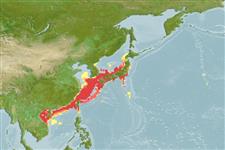分類 / Names
俗名 | 同種異名 | Catalog of Fishes(屬, 種) | ITIS | CoL | WoRMS | Cloffa
Teleostei >
Pleuronectiformes (Flatfishes)
鰈形目 (Flatfishes) >
Bothidae (Lefteye flounders)
鮃科 (Lefteye flounders)
Etymology: Crossorhombus: Greek krossoi = tassel + Greek, rhombos = paralelogram (Ref. 45335).
More on authors: Jordan & Starks.
Environment: milieu / climate zone / depth range / distribution range
生態學
海洋 居於水底的; 深度上下限 50 - 275 m (Ref. 9824). 溫帶
Northwest Pacific: Japan, Formosa Strait, northern part of the South China Sea. Possibly occurring in the Western Central Pacific.
西北太平洋: 日本,台灣海峽, 南中國海的北部。 可能出現在中西太平洋。
大小 / 重量 / 年齡
Maturity: Lm ? range ? - ? cm
Max length : 12.0 cm TL 雄魚/尚未辨別雌雄; (Ref. 9824)
背棘 (總數): 0; 背的軟條 (總數): 79-86; 臀棘 0; 臀鰭軟條: 59 - 67. Tip of isthmus below middle of lower eye. Scales on ocular side ctenoid, armed with a row of hairlike spines. Caudal fin with 3 simple rays on upper and lower margins respectively. Pectoral fin elongated into a filament, longer than head. Caudal fin without a dark band. In male, body on blind side stained with dark-blue except for head, interorbital width broader and pectoral fin longer than in female.
在眼睛下部的中央之下的峽部的頂端。 在有眼睛的一邊上的鱗片有櫛鱗的, 被覆了一列毛狀的棘。 分別地在上、下邊緣上尾鰭有 3個單一的鰭條。 胸鰭延長變成一個絲狀突起,長度超過頭部了。 尾鰭沒有深色條紋。 在雄魚中,染有深藍色的在沒有眼睛的一邊上的身體除了頭部,眼間骨寬度比較寬的與胸鰭長度超過母魚。
Lives on sand and shell bottoms and feeds on bottom-living animals. Sexually dimorphic characters develop at about 5 cm SL.
生活在沙與貝殼底部並且吃底棲動物。 性別雙型性特徵發展於大約 5 公分 SL 。
Life cycle and mating behavior
成熟度 | 繁殖 | 產卵場 | 卵 | 孕卵數 | 仔魚
西北太平洋: 日本,台灣海峽, 南中國海的北部。 可能出現在中西太平洋。
Hensley, D.A. and K. Amaoka, 2001. Bothidae. Lefteye flounders. p. 3799-3841. In K.E. Carpenter and V. Niem (eds.) FAO species identification guide for fishery purposes. The living marine resources of the Western Central Pacific. Vol. 6. Bony fishes part 4 (Labridae to Latimeriidae), estuarine crocodiles. FAO, Rome. (Ref. 9824)
IUCN 瀕危狀態 (Ref. 130435)
無危 (LC) ; Date assessed: 11 November 2019
人類使用
漁業: 沒有興趣
更多資訊
俗名同種異名新陳代謝捕食者生態毒物學繁殖成熟度產卵場產卵群集孕卵數卵卵發育
參考文獻養殖養殖資訊品種遺傳學Electrophoreses遺傳率疾病加工NutrientsMass conversion
合作者照片Stamps, Coins Misc.聲音神經毒速度泳型鰓區Otoliths腦重體重比眼睛色素
工具
特別的報告
下載 XML
網路資源
Estimates based on models
Preferred temperature (Ref.
123201): 9.7 - 21.8, mean 18.2 °C (based on 160 cells).
Phylogenetic diversity index (Ref.
82804): PD
50 = 0.5312 [Uniqueness, from 0.5 = low to 2.0 = high].
Bayesian length-weight: a=0.00912 (0.00408 - 0.02036), b=3.05 (2.87 - 3.23), in cm total length, based on LWR estimates for this (Sub)family-body shape (Ref.
93245).
營養階層 (Ref.
69278): 3.5 ±0.37 se; based on food items.
回復力 (Ref.
120179): 中等的, 族群倍增時間最少 1.4 - 4.4年 (Preliminary K or Fecundity.).
Fishing Vulnerability (Ref.
59153): Low vulnerability (10 of 100).
